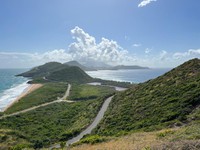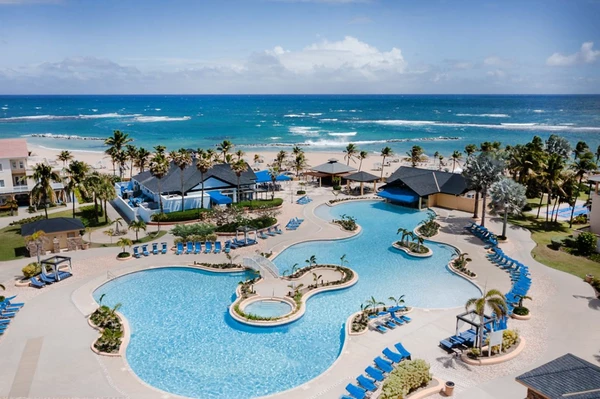Island hopping during winter? Yes, please! Visiting two islands in one trip? Even better. St. Kitts and Nevis is a small dual-island nation that is home to some of the most beautiful scenery I have come across – where the mountains appear to touch the clouds.
After your plane lands at St. Kitts’ Robert L. Bradshaw International Airport, there’s a bit of a walk from the tarmac into the actual airport. Consider it an introduction to the island spirit. My hotel, the St. Kitts Marriott Resort & The Royal Beach Casino, was 10 minutes away from the airport, a bonus for convenience.
Top-tier views & batik
I wanted to waste no time exploring the islands, beginning with St. Kitts. It would be a day full of sightseeing, with my tour guide, Cassandra Crawford, of Sunlinc. Driving around St. Kitts, you immediately notice the lush greenery and glorious azure sky.
Seeing the views from the passenger side of a vehicle is one thing, but stopping at Timothy Hill takes your breath away. This is where you’ll enjoy a 360-degree view of where the Atlantic Ocean and the Caribbean Sea meet. It’s one of the best vistas in the Caribbean.
After making our way down from Timothy Hill, we drove into downtown Basseterre, where many of the buildings from the 1800s are still standing. Independence Square – the new name given to the former Pall Mall Square after St. Kitts gained independence from Great Britain in 1983 – is the center of activity in in the capital city of Basseterre, where men, women and children were once sold into slavery. It is now a green space used primarily for cultural events.
The island isn’t overdeveloped and many of its attractions are like a step back in time, such as the Brimstone Hill Fortress National Park, a UNESCO World Heritage Site. It was designed by British military engineers and built by enslaved persons, who labored to meticulously craft the volcanic rock and limestone into the walls that protected the British from their enemies and still stand to this day.
Construction of Brimstone Hill began in 1690 and continued periodically for 100 years before completion; the fortress is nearly 800 feet high and is one of the best-preserved structures of its kind. It is now a popular site for weddings, banquets and special events.
The history of the island continued with a stop at Romney Manor, which dates back to the 1600s and was originally settled by King Tegreman of the Carib Indians. After the Carib Indian massacres, Europeans took over the site. Sam Jefferson, great-great-great-grandfather of U.S. President Thomas Jefferson, claimed the land as his own and eventually sold a portion of the 1,000-acre estate to the Earl of Romney of England, who renamed it Romney Manor. It eventually became a rum distillery and sugar plantation on the adjacent Wingfield Estate.
Romney Manor also is the home of Caribelle Batik, an on-site shop that sells batik products. Batik is an ancient Indonesian method of hand-painting textiles that covers parts that are not to be dyed with a coat of wax. The batik process takes a few days and the more colors, the longer the process. I got to watch craftsperson Ella Flemming demonstrate and narrate the highly detailed art form.
Nevis by sea
Short on time? Try Nevis by sea. It’s too tempting not to explore, especially because it takes less than 10 minutes from St. Kitts via the water taxi and costs $40 USD roundtrip. There’s also the option to take a ferry, but the travel times are longer, anywhere from 20 minutes to an hour.
The waters were a little choppy on our ride over, but we arrived in the blink of an eye. Upon arrival, regular taxis are lined up waiting to take you around town. After a bit of scrutiny, I settled on an older driver, Samuel, who also is a part-time, unofficial Nevis historian. He offered to take us on a tour of the island for $40 USD including a stop at local watering hole Sunshine’s Beach Bar & Grill, known for its Killer Bee punch. More on that later.
It was a Sunday afternoon, so the island was quiet and looked deserted, but in a peaceful way. Sunday is a day of rest in the Caribbean; most shops and businesses are closed and Nevis follows that tradition. Samuel took me to a few historical places, including the St. Thomas Anglican Church and School. Built in1643, St. Thomas claims to be the oldest active Protestant church in the Caribbean.
Next up was the Bath Hotel and Bath House, reputed to be the oldest hotel in the Caribbean. Back in its day, the rich and famous stayed there for the therapeutic hot spring baths the island is known for.
Sunshine’s on the beach
We fittingly ended our tour at Sunshine’s along Pinney’s Beach, on the island’s west coast. There are other bars and lounges along the stretch, but Sunshine’s appears to be the most popular. It was filled with tourists and locals (always a good sign), with reggae music setting the vibe. The décor is part United Nations, part island shack, with the ceiling full of flags from countries, schools and institutions. The walls are covered with license plates from just about every corner of the earth and a who’s who image gallery of celebrities, business tycoons and world dignitaries who make the obligatory visit. It’s a place to chill, eat, mingle, and be merry.
“I’ve been here 30 years,” said Sunshine’s owner, who goes by Sun. “I started with 100 EC$ (Eastern Caribbean dollars), 10 pounds of chicken and a case of Carib beer. It was a catering job for the construction workers at the [nearby] Four Seasons Hotel.”
About that Killer Bee, be careful – it can sneak up on you! The rum punch is sweet so you may think there’s no kick to it. But you would be wrong, so very wrong.
The water taxi back to St. Kitts was smooth, and taking in those cloud-capped mountains one last time was breathtaking.









